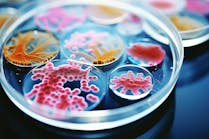HHS invests in project to accelerate the discovery and development of new antibiotics using generative AI
Sept. 30, 2024
The U.S. Department of Health and Human Services (HHS) through the Advanced Research Projects Agency for Health (ARPA-H) announced funding for the Transforming Antibiotic R&D with Generative AI to stop Emerging Threats (TARGET) project, which will use AI to speed the discovery and development of new classes of antibiotics.
TARGET will be led by Phare Bio, along with the Collins Lab at the Massachusetts Institute of Technology (MIT) and Harvard’s Wyss Institute, with a budget of up to $27 million. To accelerate the discovery and development of new antibiotics, the research team will focus on three main areas:
- Use generative AI to expand the number of antibiotic candidates. TARGET will expand the number of molecules currently being screened for antibiotic activity to include the Broad Institute’s Drug Repurposing Hub and the ZINC15 library, which collectively hold 107 million molecule candidates. The team will also broaden the number of digital molecules beyond these libraries by using generative AI to design potential antibiotic candidates from scratch.
- Use deep learning to develop new screens to test a candidate’s suitability as a pharmaceutical. TARGET will use deep learning to develop in silico (digital) screening tools to assess each molecule candidate’s effectiveness as an antibiotic and, ultimately, a pharmaceutical. For each candidate that demonstrates effectiveness, in vitro testing will be run that meets clinical and regulatory standards. The use of deep learning to narrow the field of molecule candidates will accelerate the time it typically takes to screen and should result in fewer dead-end compounds when tested in vitro and in vivo.
- Validate discoveries. Finally, TARGET will validate each new promising discovery for antibiotic activity and drug-like properties with the aim of identifying 15 promising leads for new antibiotics, which would help replenish the global pipeline.





